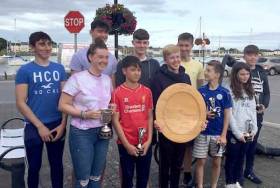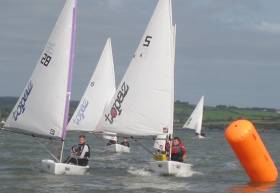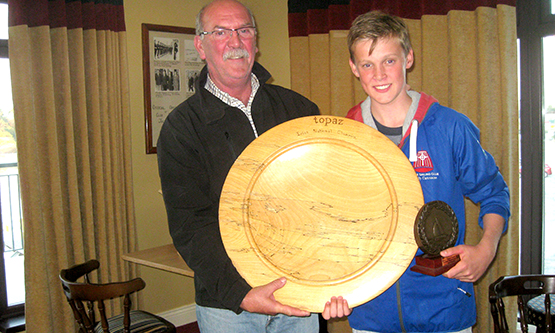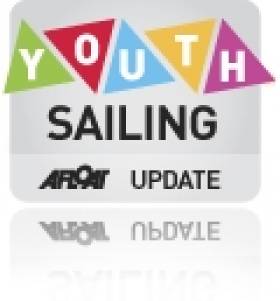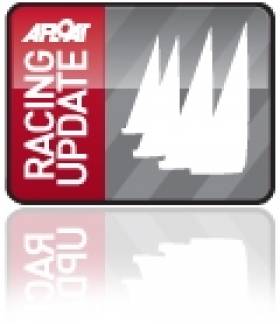Displaying items by tag: Topaz
The Topaz dinghy National Championships were held in Dungarvan Sailing Clublub in County Waterford on Saturday, August 20 with sailors from around the country competing in this annual junior sailing event.
Breezy conditions of 18-21 knots presented a solid challenge for the sailors who managed to complete all five races.
Adam Byrne from Dingle Sailing Club won four out of the five races securing the 2017 National Topaz title.
Topper Topaz National Championships 2016
This August Foynes Yacht Club will host the 2016 Topper Topaz National Championships. The event will run over two days, Saturday 13th and Sunday 14th August writes Elaine O'Mahoney.
This is the club’s second year hosting the event which last year had 34 entries. This year the club has set itself a target of 50 boats. The event is open to anyone sailing Topaz Uno (one person) or Topaz Plus (two people). We would like to invite the sailing schools to enter a fleet with a special offer to enter five and get the sixth entry free. The aim is to have a fun and exciting event with competitors ranging from seasoned sailors to complete beginners at this level with a number of entrants taking the step from Optimist and Toppers to Topaz’ for the first time.
The selection of date also allows for a nomination to be made to the Irish Sailing Association for the All Ireland Junior Sailing Championships which will be run the the Fastnet Marine OEC in Schull on the 25th & 26th September. The Irish Sailing Association makes the final decision on invitations to the All-Ireland Junior Sailing Championships.
Foynes Yacht Club are delighted for the second consecutive year to have Topper International Ltd. onboard sponsoring the overall prizes (1st Topaz Uno Racing Sail, 2nd Set of Hyde Padded Toe Straps, 3rd Carbon Tiller Extension) and also to have Ronstan (IMP Products), UK McWilliam Sailmakers and Hyde Sails generously sponsoring prizes in the different categories including under 18, under 16, under 14 and under 12, single and double handed.
Foynes Yacht Club has camping facilities on the grounds with 24 hr access to the clubhouse for showers and use of the kitchen etc.
The Notice of Race and Entry Form are available to download from the club website. If you require further information on this event contact Elaine or Simon on 087 3354153.
Cunnane Retains Topper Topaz Title At Foynes Yacht Club
Last Saturday saw Foynes Yacht Club host the Topper Topaz National Championships on the Shannon Estuary. Five races were scheduled for the one day event with one discard to be applied after the fifth race. ISA National Race Officer Geoff O’Donoghue & Local Race Officer Donal Mc Cormack where presented with a mixed bag of weather conditions which made it a challenge to complete the full schedule.
The thirty one Topper Topaz’s entries were greeted with beautiful sunshine with a twenty minute beat to the sailing area just north of Foynes Island.
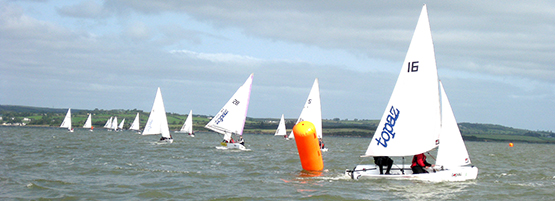
Racing got off to a great start on time in 15kts NNE with wind against tide resulting in choppy seas but great racing. However as forecasted, wind began to ease, and by race three wind had dropped down to 6kts which made it slow and tight racing but which resulted in a few boats not finishing due to pure frustration. Lunch was provided afloat from the mother ships which gave the competitors time to relax and concentrate on the final two scheduled races.
By race four the wind slightly picked again and the fleet in good numbers were back on the race course for two rounds of the triangular course. Going into the final race, it was tied at the top with Brian Fox from Tralee Bay Sailing Club level on points with 2014 champion Paddy Cunnane from Dingle Sailing Club while Mary McCormack from Foynes Yacht Club was just one point behind in third place. At least a thirty degree wind shift during the start sequence meant the start was abandoned and at the restart Brian Fox was deemed OCS. Paddy Cunnane took 1st in the final race and with it the overall championship while a third place for Mary McCormack was enough to secure the runner up spot for her, dropping Brian Fox back to third.
Dingle's Paddy Cunnane retained his title
The club were delighted to have the support of Topper International Ltd who sponsored the overall prizes, Ronstan who sponsored the prizes in the underage categories and UK McWilliams Sailmakers who sponsored a number of individual race prizes.
The Topper Topaz Class Association of Ireland have now nominated Paddy Cunnane for the All Ireland Junior Sailing Championships which will take place in Kinsale Yacht Club on the 26th & 27th September.
Final results:
1st Overall – Paddy Cunnane – Dingle Sailing Club
2nd Overall – Mary McCormack – Foynes Yacht Club
3rd Overall – Brian Fox – Tralee Bay Sailing Club
U16 - Tim Kelleher – Tralee Bay Sailing Club
U14 – Dylan Reidy/Oisín Finucane – Foynes Yacht Club
U12 – Ellie Cunnane – Dingle Sailing Club
Full results can be found attached below
Kinsale Yacht Club Hosts Top Youth Sailors for All Ireland Challenge
#youthsailing – ISAF youth silver medallist Seafra Guilfoyle is a wild card entry into this weekend's All Ireland youth sailing event at Kinsale Yacht Club this Saturday. Crosshaven based Guilfoyle, who won world silver in Portugal in July, is slated against 19 other top Irish youth sailors who will compete in the double–handed Topaz dinghy fleet.
Over 30 sailors from 11 classes were considered and the Irish Sailing Association organisers say their selection process allocated places based on the numbers of boats declared by the classes attending their national championships. The full list on invitees for the weekend fixture is published below (with some crew names missing).
The host Topaz dinghy has two nominees from its own national championships held in Dingle and the RS Feva also has two sailors attending. The Optimist class has three sailors slated including top European championships perfomers, Clare Gorman of the National Yacht Club and James McCann of Royal Cork. 420 dinghy youths are represented by national champion Peter McCann and girls champion Cliodhna NiShuillebhain of the host club.
The Mirror dinghy is also included with teams coming from Lough Ree YC and Sutton Dinghy Club.
|
Class |
Helm |
Club |
Crew |
|
RS Feva |
Alison Dolan |
Blessington SC |
Grainne Young |
|
RS Feva |
Triona Hinkson |
Royal St.George YC |
Catherine Kelly |
|
RS200 - Youth |
Stephen Craig |
Royal St.George YC |
|
|
Optimist |
James McCann |
Royal Cork YC |
Michael Carroll |
|
Optimist |
Gemma McDowell |
Malahide YC |
|
|
Optimist |
Clare Gorman |
National YC |
|
|
Mirror |
Shane McLoughlin |
Sutton DC |
Oscar Langan |
|
Mirror |
Tiarnan Dickson |
Lough Ree YC |
Rory MacAllister |
|
Topper |
Hugh Perette |
National YC |
|
|
Topper |
Ros Morgan |
Skerries SC |
|
|
Topper |
Adam D'Arcy |
Royal Cork YC |
James Hassett |
|
Laser 4-7 |
Johnny Durcan |
Royal Cork YC |
Florence Lyden |
|
Laser 4-7 |
Rory Caslin |
National YC |
Scott Levie |
|
Topaz |
Jack Kiely |
Dungarvan HSC |
|
|
Topaz |
Paddy Cunnane |
Dingle SC |
|
|
International 420 |
Peter McCann |
Royal Cork YC |
Micheal O'Suileabhain |
|
International 420 |
Cliodhna NiShuillebhain |
Kinsale YC |
|
|
GP14 - Youth |
David Johnston |
Sutton DC |
|
|
Wild Card |
Harry Durcan |
Royal Cork YC |
Harry Whittaker |
|
Wild Card |
Séafra Guilfoyle |
Royal Cork YC |
Topaz Title Won by Dingle Sailing Club Duo
Dingle Sailing Club sailors Adam Byrne and Paddy Cunnane are the Topaz Irish National Champions 2014.
The Topaz National Championships were hosted by Dingle Sailing Club for the first time on the 23-24 August 2014. The event included entries from Lough Derg Sailing Club, Dungarvan Sailing Club, Tralee Bay Sailing Club, Foynes Yacht Club, Malahide, Cork and Dingle. The Topaz sailboat is a recognised class by the Irish Sailing Association (ISA) who provided a fleet of 24 boats for the competing sailors. Full results sheet downloadable below.
Saturday saw very little breeze which tested the sailors' with light-air conditions. The first gun was at 11.30am and sailing continued until 3.30pm with a total of 4 races completed.
Several sailors reported Fungie joining Race 3 but could not be confirmed by the Race committee. Race 4 brought a stronger breeze which saw local sailor Fionn O'Regan consolidate his strong lead of at 2, 1, 1 and 1 for the 4 races. Force 6 winds were forecast for Sunday which duly arrived providing very fresh but excellent sailing conditions. The wind was blowing from the Harbour mouth (SE) which is somewhat unusual for Dingle.
These strong conditions provided some thrilling sailing especially on the broad-reach leg of the race. Race leader Fionn O'Regan from Saturday was pipped at the post by a single point which saw the National Champion title go to Dingle sailors Adam Byrne and Paddy Cunnane.
Category winners saw Dungarvan Sailing club sailor Jack Kiely take the U16 title who also finished 4th overall. Ellie Cunnane and Stephen Cunnane (DINGLESC) won the U12 title.
The U14 title went to Tralee Bay Sailing club sailors John Kelliher and Tadgh Hurley who also had a strong 5th place overall finish.
The event was managed by Race organiser Aileen O'Carroll and Race officer Colm O'Shea. Dingle Sailing Club made preparations for the event, working with the ISA and
arranging race training the week prior to the event. The club recognise that hosting events of this calibre contribute to the skills and development of our sailors and provide an opportunity for our sailors to compete and win, at the National level. Dingle Sailing Club is a community club with an ethos to make sailing accessible to all. None of this is possible without the support and help from our volunteers and sponsors.
RESULTS
FIRST PLACE, "TOPAZ IRISH NATIONAL CHAMPIONS 2014"
ADAM BYRNE (CREW) DINGLE SAILING CLUB
PADDY CUNNANE (HELM) DINGLE SAILING CLUB
SECOND PLACE
FIONN O'REGAN, DINGLE SAILING CLUB
THIRD PLACE
LIA MCCANN (HELM) DINGLE SAILING CLUB
RUAIRI GALWEY (CREW) DINGLE SAILING CLUB
CATEGORY WINNERS:
UNDER 16
JACK KIELY, DUNGARVAN SAILING CLUB
UNDER 14
JOHN KELLIHER (HELM) TRALEE BAY SAILING CLUB
TADGH HURLEY (CREW) TRALEE BAY SAILING CLUB
UNDER 12
ELLIE CUNNANE (HELM) DINGLE SAILING CLUB
STEPHEN CUNNANE (CREW) DINGLE SAILING CLUB
Sailing School Navigates Beyond the Gloom
The Principal John Moore has discounted all prices by 20 to 30%. All 2009 sailors returned in 2010 and brought friends with them. The French network of the newly appointed Director of Sailing Hugues Traonmilin has brought French families to the island and the French sailors were mixed with the Irish and British children and adults with great success. In addition to a busy summer season, 60 students of a South East College came for the very first time to the Sailing School in March 2010 as part of the Transition Year programme. They were hosted with full board accommodation at the Sailing School Guest house.
Definitely the location of the Sailing School plays a big part in this success story. Heir Island is located in the middle of Roaring Water Bay half way between Schull and Baltimore. Whatever direction you sail from the Sailing School beach, you'll encounter wonderful maritime landscapes and crystal clear waters. The Topaz dinghy fleet may sail to 3 or 4 different sandy beaches on one sailing day. The 3 Dublin Bay Mermaids sailing in flotilla explore the surrounding islands of Castle Island, Sherkin Island, the 3 Calves Islands and of course the Carthy's Islands to visit the seals colony.
Such a fantastic location has orientated the programme of this Sailing School towards the "Adventure" courses of the Irish Sailing Association. The school offers Adventure 1 & 2 courses as their "speciality" course.
2011 perspectives are already very encouraging with a second college to be hosted in Spring for a 10 day transition programme meanwhile the first one is returning after excellent feedback of the 2010 students and teachers. Being a family run business makes this small company very flexible and the range of their activities covers young sailors from 8 years old to adults, groups and families, on dinghies or on a traditional Heir Island Lobster Boat, and on kayaks if you don't want to sail. Also as a qualified Yachtmaster Instructor, the director of sailing has facilitated individually tailored sail training for yacht owners aboard their own yacht, an option that has proven both practical and successful.
More information HERE.



























